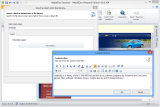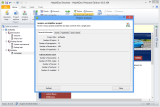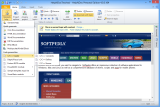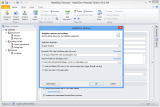Most users take for granted the help files accompanying the applications they install on the system, never thinking that some degree of work is always necessary to compile the guide so that the less experienced easily understand the purpose of the utility and how it can be handled.
The simplest way to come up with documentation for a program is to bundle in a plain text file explaining the functions and how to achieve the intended purpose; but this is far from being a professional approach.
HelpNDoc Personal has been designed specifically as an aid for developers to create the necessary file that relays to the user all the functionality encapsulated in their program along with the steps that need to be taken to reach a certain result.
The Personal edition of the application is free of charge for non-commercial use; it also has some limitations, such as displaying watermarks on each page of the documentation file.
To get rid of all limitations and to use it commercially a Professional ($366 / €249) license is required. A third edition (Standard, $146 / €99) can be used for commercial purposes, but it comes with the watermarking limitation available for the Personal version.
Regardless of the build you choose, installation is smooth and does not require too much attention. Everything is pretty standard and straightforward.
The interface is quite simple and easy to work with, especially if you are familiar with Office suites. A ribbon interface is present at the top of the application window, and you can dock it to award more space for the loaded project.
Unless you launch a previously saved project, HelpNDoc opens the list of common tasks, a panel that allows starting a new project, opening an existing one, or importing an already compiled help file in order to make modifications.
A project does not have to be started from scratch unless you really want to. When creating a new project, the most common first entries in a help file (Introduction and Getting Started) are already created along with their sub-sections: welcome note, what’s new, and system requirements.
This way, even if you are a complete beginner you have an idea about what the final result should look like.
Once you get started, it’s easy to uncover the full set of features available in HelpNDoc. The application is actually a word processor adapted to more than simple text writing needs.
The table of contents present on the left-hand side of the application window is the most important part of the document because it guides the user through the entire documentation.
As such, HelpNDoc is flexible about this part and permits arranging the entries exactly as needed: rename, move into a different category or change its position, add an icon, make it point to an external URL, display a header or footer, etc.
Each topic in the table of contents can have keywords assigned so that the user can navigate more comfortably through documentation. One keyword can point to multiple topics.
Writing the documentation is not much different than typing in a word processor. Apart from editing text, there is also the possibility to change its font, color, style, size format paragraphs, apply indentation and colors.
Spellcheck support is integrated in the program, and the list of built-in dictionaries is available at the bottom part of the application window. Verifying for errors is done as you type, and it relies on open source dictionaries over at OpenOffice.org. Download any of them from that location and add them to HelpNDoc.
Moreover, the “Insert” menu allows adding not just tables, symbols, hyperlinks, or anchors, but also images, pictures, and even video files.
HelpNDoc has support for inserting HTML code, variables (current date and time, project copyright, comment or summary, etc.) as well as adding anchors through the file for jumping easily from one related section to another.
The list of supported formats for publishing the resulting documentation includes the most popular of them (CHM, HTML, Word, and PDF) as well as eBook-specific file types such as Epub and Mobi.
However, for creating documentation in CHM and eBook format, external tools are required (Microsoft's HTML Help Workshop and Amazon Kindlegen). Fortunately, the developer included the download links in the application and both of them are free of charge.
Additionally, HelpNDoc can be used to generate C/C++ code for easy integration of the resulting documentation with this programming language. Additional languages supported are Delphi/Pascal unit, Fortran 90/95 module, PowerBASIC, and Visual Basic module.
The built-in script editor allows the automation of repetitive tasks. It can be used for managing projects, topics, and keywords.
The general configuration of the application is limited to setting the working language and providing the executable files for Kindlegen and Microsoft HTML Help Workshop.
The Good
The Bad
The Truth
The application offers a simple way to organize the table of contents as well as to move from one area to another. It is a good tool, but the Personal edition applies watermarks and cannot be used commercially.
 14 DAY TRIAL //
14 DAY TRIAL // 








